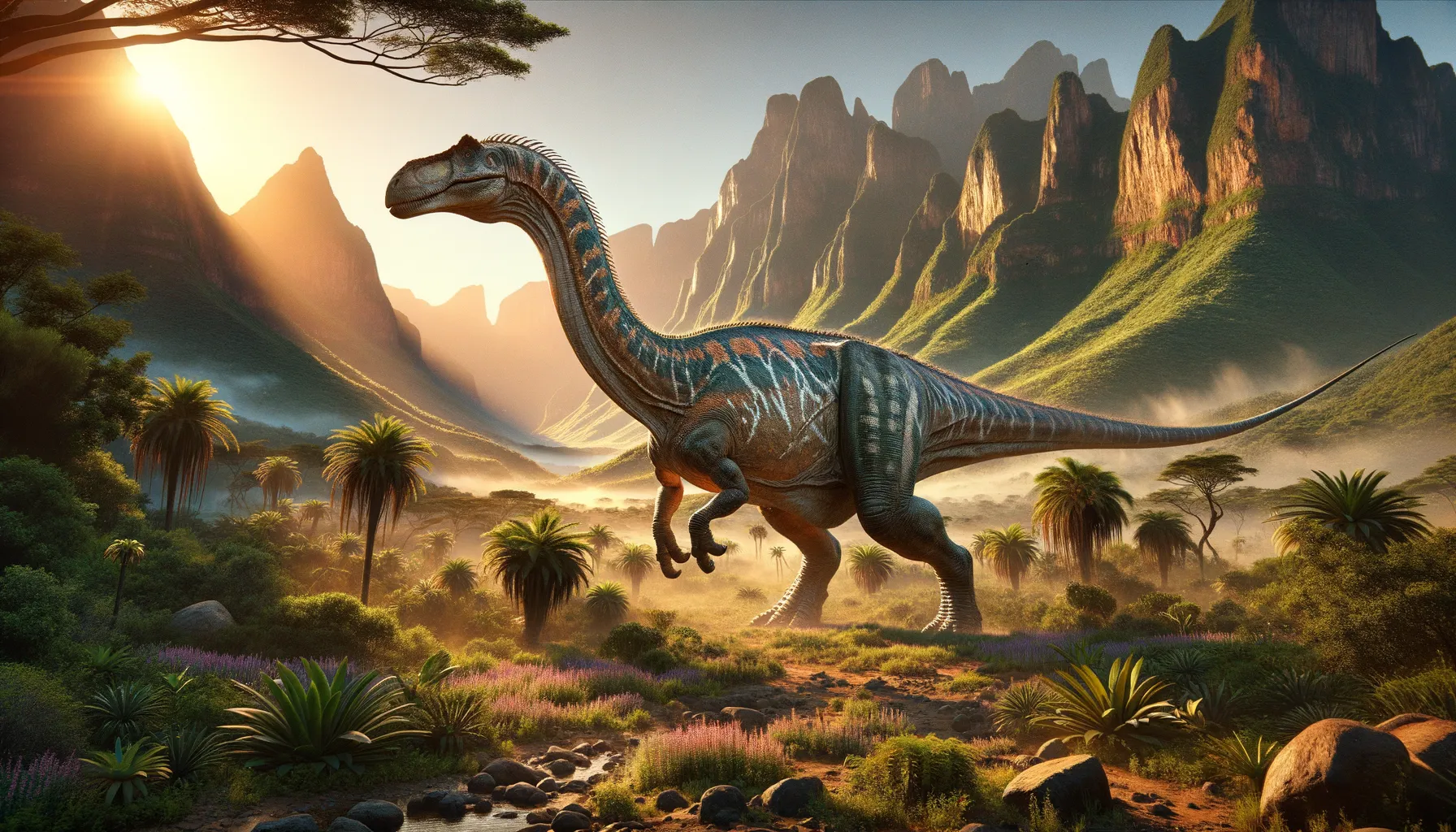
Eucnemesaurus
Early giant on the path to greatness.
Period
Triassic
Length
Approximately 9-10 meters long.
Height
Around 2-3 meters at the hips.
Weight
Roughly 500-1000 kilograms.
Eucnemesaurus was a large, herbivorous dinosaur from the Triassic period, known for its strong limbs and long neck. It roamed the ancient landscapes of what is now South Africa. This dinosaur was part of the early evolution of sauropodomorphs, paving the way for later giants. Its bones suggest it had a powerful physique, adapting to a life of grazing on foliage and navigating diverse terrains.
Diet
Eucnemesaurus was a herbivore, primarily feeding on the lush vegetation of its time. Its diet included a variety of ferns and cycads, which were abundant in its environment. The dinosaur had flat teeth suitable for grinding plant material.
Hunting
Not being a predator, Eucnemesaurus did not exhibit traditional hunting behavior. Instead, it foraged for plants, leveraging its ability to reach high foliage with its elongated neck. It explored its surroundings for food, carefully avoiding predators.
Environmental challenges
Eucnemesaurus lived during a time of significant climatic changes, which included fluctuations between wet and dry conditions. These shifts posed challenges in food availability, requiring adaptations to forage efficiently. Its robust build helped it travel longer distances in search of sustenance during lean seasons. Competition with other herbivores for resources also shaped its survival strategies.
Speed
Moderate, adapted for steady movement.
Lifespan
Estimated around 30-40 years.
First discovery
Found in South Africa in the late 19th century.
Fun Facts
- Eucnemesaurus was a dinosaur that lived around 210 million years ago during the Late Triassic period.
- This dinosaur was a herbivore, meaning it primarily ate plants.
- Eucnemesaurus belonged to a group of dinosaurs called sauropodomorphs, which were early relatives of the giant long-necked dinosaurs we think of today.
- Its name means 'well-boned lizard,' a nod to its robust limb bones, which suggests it had strong legs.
- Fossils of Eucnemesaurus have been found in South Africa, giving us insight into its habitat and lifestyle.
- Although not very big compared to some of its later relatives, this dinosaur could still grow up to 10 feet long.
- Eucnemesaurus helps scientists understand the transition from early, small plant-eating dinosaurs to the gigantic sauropods that came later.
Growth and Development
The growth of Eucnemesaurus was relatively steady, as evidenced by its bone structure. Young dinosaurs likely grew under the protection of their herd, benefiting from communal living. Over time, their strong limbs developed to support their large body mass. As they matured, they became more adept at foraging and navigating their environment.
Habitat
Eucnemesaurus thrived in semi-arid landscapes interspersed with lush vegetation near water sources. These areas provided ample food and were crucial for their sustenance and survival. The dinosaur's habitat had diverse terrains, requiring adaptations for effective movement. Water availability influenced their migratory and foraging patterns significantly.
Interaction with other species
While Eucnemesaurus primarily interacted with plant species, it also coexisted with various other dinosaurs. These interactions often centered around competition for food resources. It might have had encounters with early carnivorous dinosaurs, although it usually relied on its strength and size for defense. Such interactions played a minor yet impactful role in its daily life.
Natural lifespan
Eucnemesaurus had a natural lifespan of around 30 to 40 years.
Reproduction
Eucnemesaurus reproduced oviparously, laying eggs in nests. These nests were likely constructed in sheltered areas to protect against predators and environmental threats. Parent dinosaurs may have exhibited some level of nest guarding, although this behavior is still speculative. The hatchlings relied on parental guidance and herd protection in their early stages.
Social behaviour
Eucnemesaurus is believed to have lived in herds, a strategy that offered protection and collective foraging benefits. Such social structures were vital for survival, against predators and during resource scarcity. Communication within the herd was likely facilitated through vocalizations and body language. This social lifestyle helped in educating the young and promoting survival skills.
Fossil locations
Fossils of Eucnemesaurus have predominantly been found in South Africa, highlighting its geographical range. These discoveries in the Karoo Basin have been instrumental in understanding its morphology and lifestyle. The fossil record provides valuable insights into its environment and adaptation mechanisms. Ongoing excavations continue to unearth crucial data about this early dinosaur.
